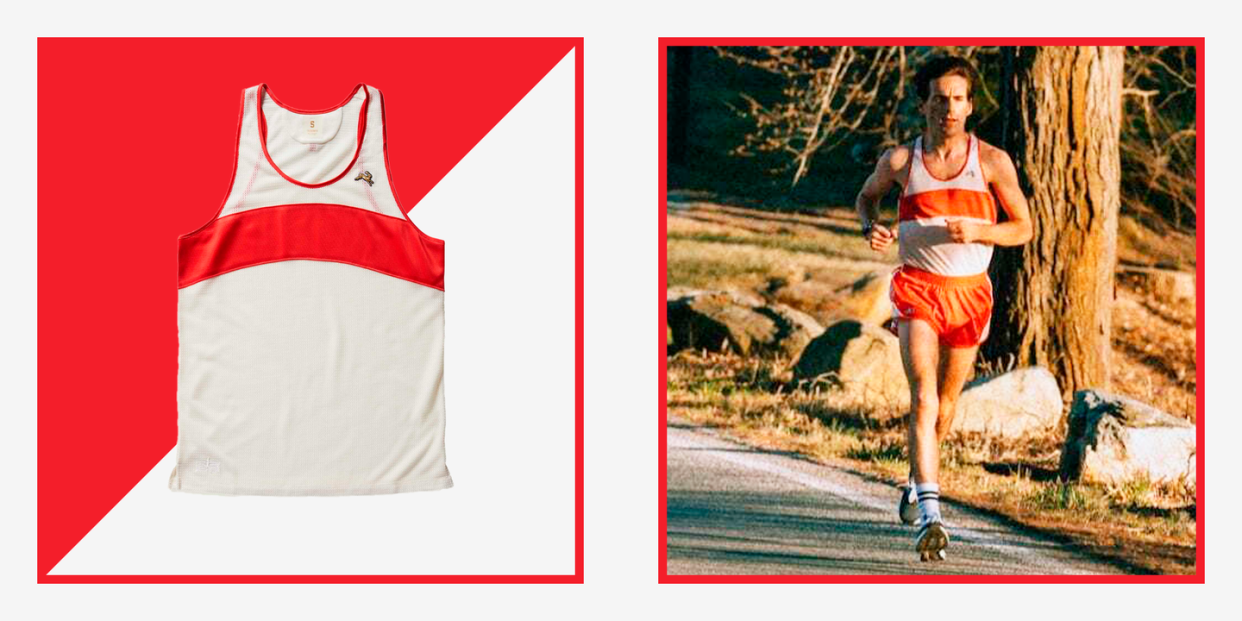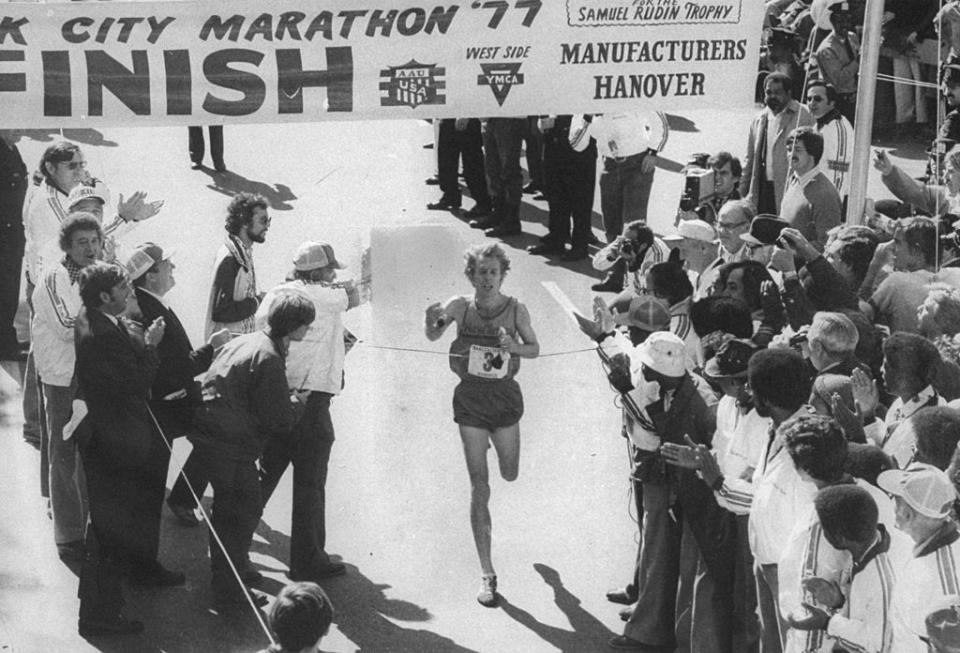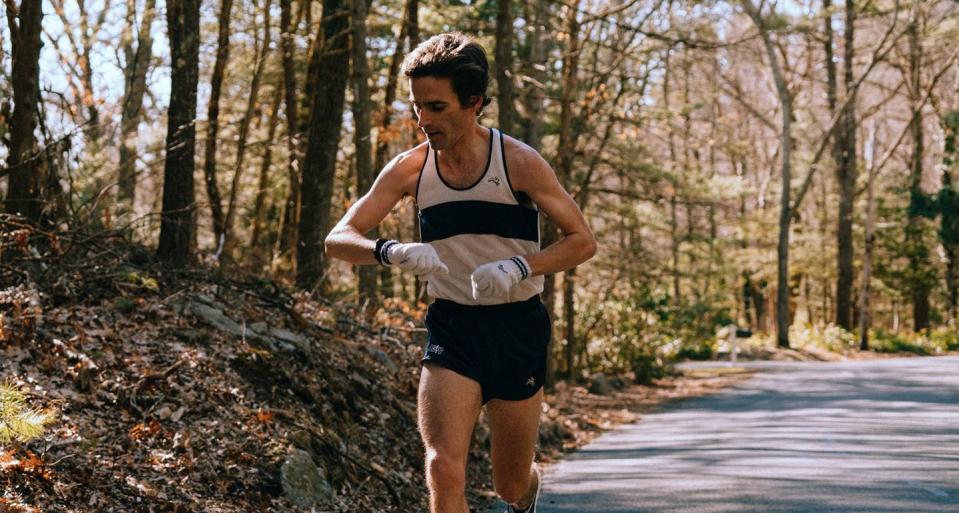Marathon Legend Bill Rodgers Is an Icon of Running's Past. His New Line Shows Its Future.

- Oops!Something went wrong.Please try again later.
Picture this: You’re ready to sprint into action and set a new PR, but instead of wearing your go-to moisture-wicking running shirt and lightweight 5-inch workout shorts, you’re wearing heavy sweats that’ll weigh you down as you perspire and a ratty T-shirt made of questionable material that's bound to fuel some serious nipple-chafing nightmares.
No, this isn't some sort of reality show challenge, but it was a reality for many runners back in the ‘60s and early ‘70s. One guy you can thank for changing all that is Bill Rodgers, the famous Olympian and four-time Boston Marathon winner.
“Our entire sport was backwards, in some ways,” says Rodgers. “When you think of the past, you can understand why hardly anyone wanted to get out there and run. So I really think the running boom happened due to changed in running gear. When you feel like you can succeed, and you have good gear, nothing can stop you.”
Rodgers' surprise Boston Marathon win in 1975 catapulted “Boston Billy” into running world stardom. Soon after, Rodgers and his brother Charlie opened their first store in 1977. And like Olympic gold medalist Frank Shorter and legendary runner Ron Hill, Rodgers would go on to launch his own sportswear line, and that line has been credited with shaping the future of innovative running wear that we don on the track today. With the help of a design team, Bill Rodgers & Company produced breathable, non-abrasive mesh singlets and thoughtful running shorts silhouettes for ease in movement.

“They were classically styled, and even today, feel like timeless pieces of athletic wear,” says Matt Taylor, founder and CEO of Tracksmith, who purchased a box of Bill Rodgers & Company apparel while doing research for his own running gear brand. “There were some really interesting material choices that were innovative for the ‘70s and ‘80s. But even today, I could see there was some serious thought that went into these pieces. If you look at the evolution of sportswear, that’s when things went from not technical at all to getting more and more technical.”
But Rodgers’ star status didn’t necessarily prepare him for entering the business world, especially with unexpected challenges, such as contributing quarterly payments to USA Track & Field.
“We always felt like we were going against the wind—you know, the rules that controlled us,” says Rodgers. “In a way, it made us more competitive as athletes, but I think the key was to have some really comfortable gear for everybody, men and women. And in ’78, we did that. We did well as a company for quite a while until the shoe companies really got into running gear.”
Competing with powerhouse performance brands might have proved to be too difficult of a feat for Bill Rodgers & Company, but its achievements and innovations still inspire brands like Tracksmith decades later. That legacy serves as the inspiration for a new collaboration between Rodgers and the boutique running apparel brand. The Tracksmith Bill Rodgers Collections offers updated versions of Rodgers' iconic running fits, including a singlet, jacket, shorts, and a rugby shirt.
“Other than the update of materials that make it modern and high performance, you’d be hard-pressed to know which one is the old one and which one is the new one,” says Taylor when comparing Billy’s original singlet and the one in the Tracksmith collection.
If you’re familiar with Tracksmith, you’ll instantly recognize similarities in design aesthetics that make this partnership so fitting. But it’s not because Tracksmith is trying to tap into a retro or vintage vibe of the moment—the brand simply wants to offer timeless pieces you’ll cherish and love to run in, now and forever.

“I think as fashion evolves and moves through different categories, you see certain trends pushed for periods of time, but it always cycles back to classic design,” says Taylor. “So it’s not so much that I think we’re in an era of vintage collecting and replication as much as we are just back to what’s timeless, what’s classic, what can I invest in now that’s still going to feel relevant a year or two from now.”
If the history of running gear provides any insights into the future of performance apparel, it’s going to have that same classic style we love, but with more fabric innovations that allow us to perform at our best, and ultimately, allow us to enjoy our favorite sports even more. And according to Rodgers, enjoying sports and fitness activities is more important now than ever before.
“The tough time is when you’re out of high school or college and you think you’re done with your sport and you’re trying to find your way in the world,” says Rodgers. “And particularly during a pandemic it’s tougher than ever, but when you have an activity like swimming or cycling or running to give you that psychological strength, you can cope with your job better, you can cope with the pandemic better.”
The collection celebrates the past, present, and future of long-distance running, but maybe even more so, it celebrates the idea of community through sports, benefitting our mental wellbeing as much as our physical health.
“Go for it!,” says Rodgers about tackling new fitness challenges, like marathon running. “Maybe you have fast-twitch muscle fibers and you’re better suited for a 5k, and you can do really well on the 5k. We’re all explorers and trying to find what we’re best at—for me it turned out to be a marathon.”
You Might Also Like

